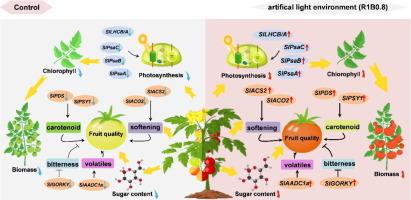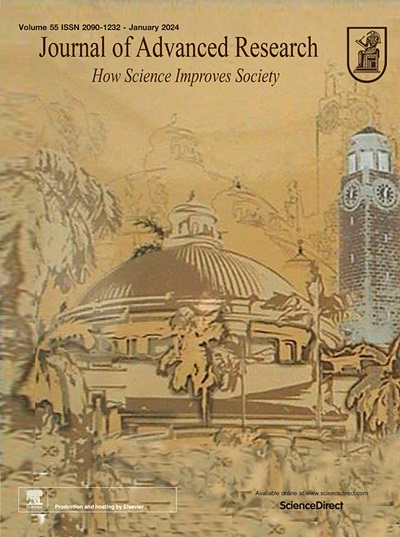操纵人工光环境可提高番茄的植株生物量和果实营养质量
IF 11.4
1区 综合性期刊
Q1 MULTIDISCIPLINARY SCIENCES
引用次数: 0
摘要
引言 番茄(Solanum lycopersicum.L)冬季光照强度低、光周期短,产量和质量往往下降。本文旨在研究红(R)光和蓝(B)光之间的适当平衡,以提高番茄的产量和品质性状。结果与白光(W)处理相比,R1B0.8(单色红光(R)和蓝光(B)的比例)光周期下的番茄植株叶绿素和生物量积累显著增加。R1B0.8 光处理通过提高光能利用率、诱导光合系统核心亚基基因(SlPsaC、SlPsaB、SlPsaA)和光收集复合体基因(SlLHCB/A)来提高电子传递效率和光合作用能力。与 W 光相比,R1B0.8 光还能诱导类胡萝卜素积累并加速果实成熟,这与番茄果实中类胡萝卜素生物合成基因(SlPSY1、SlPDS)和乙烯生物合成基因(SlACS2、SlACO2)的上调有关。结论我们的研究结果表明,16 小时光周期的 R1B0.8 光照可显著促进番茄的光合性状、色素、糖分和挥发性物质的积累。我们在保护性园艺中对人工光环境的研究结果为提高作物产量和质量以满足全球日益增长的粮食需求提供了可能性。本文章由计算机程序翻译,如有差异,请以英文原文为准。

Manipulation of artificial light environment improves plant biomass and fruit nutritional quality in tomato
Introduction
The yield and quality of tomato (Solanum lycopersicum. L) are often decreased when plants suffer from low light intensity and short-photoperiod in winter. Manipulation of the artificial light environment is a feasible technology to promote off-seasonal production and improve fruit nutritional quality in the greenhouse.Objectives
Here we aim to investigate the appropriate balance between red (R) and blue (B) light to improve tomato yield and quality traits.Methods
Biochemical, molecular and genetic analysis were used to study the photosynthetic traits, pigments, sugar and volatile accumulation pathway genes.Results
Tomato plants subjected to R1B0.8, a ratio between monochromatic red (R) and blue (B) light, for 16 h photoperiod showed significantly increased chlorophyll and biomass accumulation compared to white (W) light treatment. R1B0.8 light treatment enhanced electron transfer efficiency and photosynthetic capacity by improving the light energy utilization rate and inducing photosystem core subunit genes (SlPsaC, SlPsaB, SlPsaA) and light-harvesting complex genes (SlLHCB/A). Compared to W light, R1B0.8 light also induced carotenoid accumulation and accelerated fruit ripening, which was associated with the upregulation of carotenoid biosynthesis genes (SlPSY1, SlPDS) and ethylene biosynthesis genes (SlACS2, SlACO2) in tomato fruits. Moreover, fruits exposed to R1B0.8 light treatments significantly improved fructose and glucose accumulation and the expression of the volatile-related gene (SlAADC1a) and flavor-related gene (SlGORKY).Conclusion
Our results showed that R1B0.8 light with a 16 h photoperiod could prominently promote photosynthetic traits, pigments, sugar and volatile accumulation in tomato. Our findings on the manipulation of artificial light environments in protected horticulture offer possibilities for enhancing crop yield and quality to meet the increasing global demand for food.求助全文
通过发布文献求助,成功后即可免费获取论文全文。
去求助
来源期刊

Journal of Advanced Research
Multidisciplinary-Multidisciplinary
CiteScore
21.60
自引率
0.90%
发文量
280
审稿时长
12 weeks
期刊介绍:
Journal of Advanced Research (J. Adv. Res.) is an applied/natural sciences, peer-reviewed journal that focuses on interdisciplinary research. The journal aims to contribute to applied research and knowledge worldwide through the publication of original and high-quality research articles in the fields of Medicine, Pharmaceutical Sciences, Dentistry, Physical Therapy, Veterinary Medicine, and Basic and Biological Sciences.
The following abstracting and indexing services cover the Journal of Advanced Research: PubMed/Medline, Essential Science Indicators, Web of Science, Scopus, PubMed Central, PubMed, Science Citation Index Expanded, Directory of Open Access Journals (DOAJ), and INSPEC.
 求助内容:
求助内容: 应助结果提醒方式:
应助结果提醒方式:


